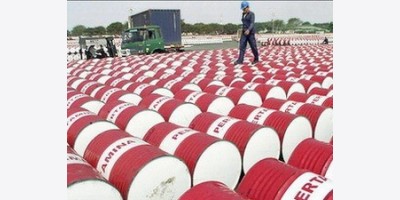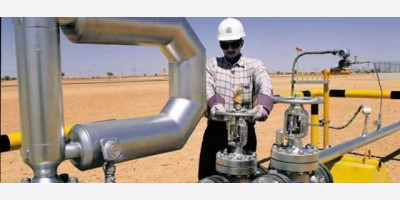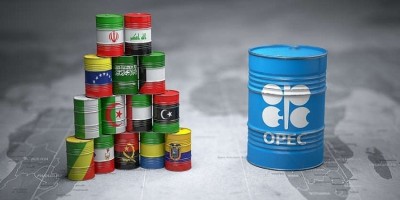Oil prices mixed in Asia
Singapore - Oil prices were mixed in Asia Wednesday as investors await the release of US Federal Reserve minutes from its July meeting, while keeping an eye on the latest stockpiles data.
US benchmark West Texas Intermediate (WTI) for September delivery rose 34 cents to $94.82 on its last day of trading. It tumbled $1.93 in New York Tuesday as speculative traders sold off ahead of its expiration date.
Brent crude for October eased three cents to $101.53.
Desmond Chua, market analyst at CMC Markets in Singapore, said dealers are squaring positions before they scrutinise the minutes of a two-day Fed meeting that ended on July 30.
Investors will be looking at whether the minutes "reveal anything insightful pertaining to tightening monetary policy", Chua said.
Bank policymakers have said the Fed will hold its near-zero interest rate policy until the US economy strengthens but may raise rates if the jobs market kept improving.
Dealers are also awaiting the latest official US stockpiles report later Wednesday from the Department of Energy, with expectations for a decline.
Crude oil stocks are projected to have fallen by 900 000 barrels on average in the week to August 15, according to analysts surveyed by the Wall Street Journal.
Gasoline stockpiles are expected to have fallen by 1.3 million barrels, while stocks of distillates, which include heating oil and diesel, are expected to have dropped by 700 000 barrels.
A decline in US stockpiles typically indicates strong demand in the world's top crude consumer, supporting global prices.
Markets are continuing to track conflicts in crude producers Libya and Iraq, as well as in Ukraine, a key conduit for Russian gas exports to Europe, analysts said.
OPEC unruffled by oil price slide, sees market rebound : delegates
The Organization of the Petroleum Exporting Countries (OPEC) logo is pictured at its headquarters in Vienna June 10, 2014. REUTERS/Heinz-Peter Bader
The Organization of the Petroleum Exporting Countries (OPEC) logo is pictured at its headquarters in Vienna June 10, 2014.
Credit: Reuters/Heinz-Peter Bader
(Reuters) - OPEC is not worried about a slide in oil prices toward $100 a barrel, delegates from the producer group said, with current levels seen as acceptable for producers while higher seasonal demand in the coming weeks was expected to support the market.
Brent crude fell to a 14-month low of $101.11 a barrel on Monday as investor concerns over conflict in Ukraine and Iraq eased and Libyan output rose. The drop brought prices below the level some in OPEC need for their budget needs.
But delegates from three members of the Organization of the Petroleum Exporting Countries told Reuters on Tuesday the decline in prices was not an immediate concern.
"There's no reason to worry," said a delegate from one of OPEC's Gulf members. "We see the dip as a correction. Action will only be taken based on fundamentals and for the time being the price is still fair for producers."
He did not comment on what price would prompt concern in OPEC. Brent is still above the $100-mark favored by top exporter Saudi Arabia, which many others in the 12-member group also support.
Prices need to fall further to be outside an acceptable zone cited by Saudi Oil Minister Ali al-Naimi in June, when OPEC last met to review its output policy. Oil at "$100, $110, $95 is a good price," he said.
An oil official from an African OPEC member took a similar view of the price drop to the Gulf delegate.
"It's just a seasonal phenomenon," the official said. "The price will probably go back up in the autumn when demand picks up. There is no reason for panic. Anyway, the price will not go below $100."
OPEC has a nominal target to produce 30 million barrels per day and in July, pumped around that level, according to a Reuters survey. The organization is not scheduled to meet to review its output policy until November.
But Saudi Arabia, Kuwait and the United Arab Emirates could trim supply informally if needed, such as to make room for a further recovery in Libya or to support prices, said an OPEC source.
In the last few years, OPEC has left its target unchanged and left market management to informal supply tweaks by the three Gulf producers.
"The Gulf countries could cut back if they see a need," the source said. "Other than that, I've not heard of any concern."
Iraqi Kurdistan oil pipeline export capacity to double
A still image from video taken by a U.S. Coast Guard HC-144 Ocean Sentry aircraft shows the oil tanker United Kalavyrta (also known as the United Kalavrvta), which is carrying a cargo of Kurdish crude oil, approaching Galveston, Texas July 25, 2014. REUTERS/US Coast Guard/handout via Reuters
A still image from video taken by a U.S. Coast Guard HC-144 Ocean Sentry aircraft shows the oil tanker United Kalavyrta (also known as the United Kalavrvta), which is carrying a cargo of Kurdish crude oil, approaching Galveston, Texas July 25, 2014.
Credit: Reuters/US Coast Guard/handout via Reuters
Related Topics
Aerospace & Defense »
(Reuters) - The capacity of Iraqi Kurdistan's independent oil pipeline will almost double to at least 200,000 barrels per day by the end of this month, helping the semi-autonomous region increase exports and revenue, industry sources and officials said.
Oil revenues are a lifeline for the Kurdish Regional Government (KRG) in northern Iraq, whose peshmerga forces are being supported by U.S. air strikes in their battle against the radical Sunni militants of Islamic State.
"Work to increase the capacity will probably be completed by the end of this month. Once it is completed, pumping can increase to up to 220,000 barrels per day (bpd)," one Turkish official told Reuters.
Industry sources also said the capacity of the pipeline to Turkey, which began operating at the start of this year, was set to rise to around 200,000-220,000 bpd from 100,000-120,000 bpd before the flow stopped for upgrade work.
One of the sources said capacity could climb to 250,000 bpd in two to three months' time.
"The crude flow is set to restart when the upgrade work is finished, but the 200,000 bpd to 220,0000 bpd of crude flow will be dependent on the rising oil production in northern Iraq," one official said.
A joint venture of Anglo-Turkish company Genel Energy and Sinopec's Addax Petroleum is working to ramp up production in the Taq Taq oilfield, Iraqi Kurdistan's largest, to 140,000 bpd by the end of this month.
After months of fruitless talks with Iraq's central government, the KRG in May started to export crude on its own independent pipeline to the Turkish Mediterranean export terminal of Ceyhan.
The KRG pipeline is located at a distance from the areas controlled by Islamic militants.
The move has infuriated Baghdad, which claims the sole authority to manage Iraqi oil. It has cut allocations to the KRG in the budget and has tried to block KRG's oil sales by taking legal action. [ID:nL6N0QL31Q]
So far, 7.8 million barrels of Kurdish oil have flowed through the independent pipeline, of which 6.5 million have been loaded onto tankers for export.
The Kurds have managed to load seven export cargoes from Ceyhan, according to Turkish Energy Minister Taner Yildiz.
EXPORTS FINDING CUSTOMERS
The tricky part for Iraqi Kurdistan has so far been to find buyers to export the oil. Baghdad's persistent efforts to block sales initially deterred some customers.
Iraqi Kurdistan delivered its third major cargo of crude oil out of Ceyhan and a fourth was sailing to Croatia on Friday.
Around $350 million in oil sales have been completed or are under way from shipments sent via the KRG pipeline, a Reuters analysis of satellite tracking data shows.
One cargo of Kurdish crude aboard the United Kalavrvta tanker has been sitting off the Texas coast since late July after Baghdad asked a court to seize the vessel. The ship remains in international waters, unable to unload, while the KRG has appealed the case.
The KRG has said it plans to increase oil sales to around 1 million bpd by the end of 2015, which could give it enough economic clout to speed a move to independence.
Meanwhile, a drive earlier this month by Islamic State militants through northern Iraq to the border with the Kurdish region has alarmed Baghdad, drawn the first U.S. air strikes since the end of American occupation in 2001 and sent tens of thousands of Yazidis and Christians fleeing for their lives.
"We provide a lifeline to this region; we boost the economy. Our machines have not stopped; all our staff both expats and locals are at work. Our target is to improve production," Onder Tekeli, general manager of Taq Taq Operating Company (TTOPCO), told Reuters during a short ride inside the facility.
On Tuesday, Iraqi forces launched an offensive to drive Islamic State fighters out of Tikrit, but they halted their advance after facing fierce resistance, officers in the operations room told Reuters.
The Sunni militants' advance towards Arbil, which followed a shockingly fast seizure of Iraq's third-biggest city Mosul in June, have stunned the international community and prompted Western oil companies including ExxonMobil and Chevron to evacuate staff.
The fall in oil output from the region has been negligible, however.
Once Asia's top buyer, Indonesia faces weak diesel imports for years to come
An employee fills a vehicle with diesel at a fuel station in Samarinda in Indonesia's East Kalimantan province May 23, 2008. REUTERS/Yusuf Ahmad
An employee fills a vehicle with diesel at a fuel station in Samarinda in Indonesia's East Kalimantan province May 23, 2008.
Credit: Reuters/Yusuf Ahmad
(Reuters) - Previously ranked as Asia's top diesel importer, now No.3 Indonesia is expected to take a third less of the fuel this year as demand from mining falters and biodiesel use in transport and industry grows with a mandate implemented in January.
With the government also aiming for another hike in the country's heavily subsidized fuel prices to help cap a widening current account deficit, a recovery in demand is unlikely for at least the next couple of years by most estimates.
The drop in Indonesia's imports - which cover about a third of demand - will feed a growing Asian surplus and could pull diesel margins below a more than 3-1/2-year low hit in June. That's going to hurt suppliers in Singapore and South Korea, who are also seeing a similar drop from buyers across the region.
Asian economies are slowing and regional diesel demand has slumped, just as new refining capacity and upgrades swell supply of the fuel. China this year is set to post its first decline in diesel demand in more than a decade.
"We see a decline in diesel demand due to several factors - a slowdown in the mining sector, higher use of biodiesel and the (Indonesian) retail price hike made in 2013," said Suresh Sivanandam, an analyst at oil consultancy Wood Mackenzie.
In Indonesia, with elections over and a new president taking office in October, the incumbent government is trying to raise fuel prices again, a move that is expected to further reduce consumption.
Indonesia hiked its diesel prices by more than 20 percent in the middle of last year, bringing growth in domestic consumption of the fuel to a standstill for 2013, according to Woodmac and Vienna-based oil consultant JBC Energy.
Indonesia's diesel demand is expected to drop to 455,000 barrels per day (bpd) this year, from 497,000 bpd last year, before recovering slightly in 2015, Woodmac says.
With state-run Pertamina's [PERTM.UL] oil refineries having the capacity to cover only about two-thirds of domestic demand, the slump in use will be felt mostly in imports.
Indonesia's imports of diesel have already slowed on average to 3 million-4 million barrels a month, down from 5 million-6 million barrels a month last year, according to diesel traders dealing with shipments of the fuel into the country.
That represents a fall of about 65,000 bpd, keeping Indonesia as the third largest among Asia's diesel importers.
Diesel is Asia's most widely consumed fuel, used in power generators, factories, trains and trucks. Given its broad applications, the product is often seen as a gauge of a country's industrial activity and economic health.
MINERS AND MARGINS
Prior to new mining rules that forced many miners to cut or halt output this year, diesel demand from the sector had already been fading since 2012 due to a drop in coal prices that curtailed mining activity.
Diesel is used in machines and for hauling ores, and when mining activity dwindles, demand falls.
Indonesia's mineral exports were down 27 percent in the first half of the year compared with a year ago, primarily due to the change in the mining laws.
"I don't think diesel demand is going to recover anytime soon," said a trader who supplies diesel to mining companies and does not expect an improvement in diesel use until 2017.
Asia's diesel margin - the profit made turning crude into the fuel - hit its lowest since late 2010 at $12.99 a barrel above Dubai crude at the end of June, Reuters data showed.
The margin was $15 a barrel on Tuesday, still below values seen over most of the past 3-1/2 years.
Even if the ore export issues are resolved, low prices for commodities such as coal and copper mean diesel demand from the sector is not likely to get much of a boost, said the trader dealing with the mining companies.
DIESEL DEMAND TO DROP FURTHER
JBC Energy has Indonesia's diesel demand higher this year than Woodmac - at 482,000 bpd - but sees demand dropping off slowly before eking out a recovery in 2019-2020.
It will take that long for consumption patterns to adapt to a higher price environment, JBC said in an e-mail to Reuters.
"The substitution away from using diesel for power generation and industrial purposes will weigh down on demand," the consultancy also said.
Indonesia's new biodiesel mandate that went into effect this year is expected to pull down use of conventional diesel, even though the country is not likely to hit the ambitious biofuel targets set for 2014.
Southeast Asia's biggest producer of palm oil introduced in August a year ago the regulation boosting the use of palm-based biodiesel, in a move to cut its oil import bill. The regulation took effect at the beginning of this year.
"That will definitely cut down on import volumes as they won't need as much diesel," said a middle distillates trader who supplies diesel to the Indonesian market.
Crude rises towards $95 amid stock fall, Gaza conflict
TOKYO, Aug 20 (Reuters) - U.S. crude oil futures rose closer to $95 in early Wednesday trade, after tumbling close to $2 in the previous session, on a deeper than expected petroleum stock fall and increased tensions in the Middle East.
FUNDAMENTALS
* U.S. crude futures for September delivery had risen 37 cents to $94.85 a barrel by 0002 GMT, after plunging $1.93 on Tuesday amid a rush of selling before the frontmonth contract's expiry.
* U.S. crude oil stockpiles fell by 1.4 million barrels in the week to Aug. 15, compared with analysts' expectations for a decrease of 1.2 million barrels, data from industry group the American Petroleum Institute showed on Tuesday.
* The U.S. Energy Information Administration, a government body, will issue its own weekly petroleum inventories report later on Wednesday.
* A ceasefire in the Gaza Strip collapsed on Tuesday, with Palestinian militants firing dozens of rockets at Israel and Israel launching air strikes that health officials said killed three people including a woman and a young girl in Gaza.
* The capacity of Iraqi Kurdistan's independent oil pipeline will almost double to at least 200,000 barrels per day by the end of this month, helping the semi-autonomous region increase exports and revenue, industry sources and officials said.
* OPEC is not worried about a slide in Brent oil prices towards $100 a barrel, delegates from the producer group said, with current levels seen as acceptable for producers while higher seasonal demand in the coming weeks was expected to support the market.
MARKETS NEWS
* The U.S. dollar hit nine-month highs against the euro and rose against a basket of major currencies on Tuesday after strong U.S. housing data bolstered expectations for an earlier-than-expected rate hike from the Federal Reserve.
* U.S. equities ended higher for the second straight session on Tuesday, as robust housing data and strong earnings from Dow component Home Depot overshadowed lingering concerns about the conflict in Ukraine.
DATA/EVENTS
* The following data is expected on Wednesday: (Time in GMT)
0600 Germany Producer prices July
1800 Federal Reserve releases minutes of July 29-30 meeting (Reporting by James Topham; Editing by Joseph Radford)
U.S. crude sinks for second day ahead of contract expiry
* Libyan output, exports continue to recover
* Conflict and unrest remain a risk to oil supply
* Coming up: weekly government data on U.S. inventories (Updates with API inventories)
NEW YORK, Aug 19 (Reuters) - U.S. crude oil dropped nearly $2 on Tuesday, falling for a second straight day as a rush of selling ahead of the session close brought the contract to its lowest price since January.
U.S. front-month September crude fell sharply a day ahead of its contract expiration, hitting a session low of $94.27, its lowest in seven months, before paring losses to close at $94.48 a barrel, down $1.93.
"There were physical sellers into the close, and not enough buyers. It was pure fundamentals on the trading," said Bill Baruch, senior market strategist at iitrader.com in Chicago.
U.S. October crude fell by 89 cents to settle at $92.86.
Brent crude edged lower, notching a fresh 14-month low during Tuesday's session as the prospect of increased Iraqi and Libyan oil supplies weighed on the market.
Brent crude oil for delivery in October fell 4 cents to settle at $101.56 a barrel, after falling to $101.07, the lowest since June 2013, the same month Brent prices were last below $100 a barrel.
Several analysts said Brent was testing support around $101, noting the proximity of Tuesday's low to Monday's low of $101.11.
U.S. RBOB gasoline futures rose by more than 1 percent, after a report by industry intelligence company Genscape of decreased activity in a crude unit at Irving Oil Ltd's 300,0000-barrel-per-day refinery in St. John, New Brunswick.
PBF Energy Inc also reported flaring at its Delaware City, Delaware, refinery due to an external power disturbance.
Russia's Lukoil said on Tuesday it had shipped 1 million barrels of oil produced from southern Iraq's giant West Qurna-2 oilfield, its first shipment from the field, despite a surge of violence in Iraq.
Libya also was due on Tuesday to start loading its first crude oil tanker in a year from Es Sider port, and Libya's National Oil Corp said the country's oil production had risen to 562,000 bpd, up from 535,000 bpd last weekend.
Delegates from the Organization of the Petroleum Exporting Countries said the group is not worried about a slide in oil prices towards $100 a barrel, with current levels seen as acceptable for producers while higher seasonal demand in the coming weeks was expected to support the market.
Threats to supply remain however, as Iraqi forces halted their offensive to recapture Tikrit because of resistance from Islamic state fighters.
"There is still political risk out there, and certainly the Brent contract is vulnerable to that much more so than the U.S. crude contract," said Stephen Schork, editor of The Schork Report in Villanova, Pennsylvania.
British inflation eased more than expected in July after hitting a five-month high in June and U.S. housing starts rebounded strongly in July, while only a moderate increase in U.S. consumer prices suggested the Federal Reserve has room to keep interest rates low.
U.S. crude oil and refined product stockpiles were forecast to have fallen in the week to Aug. 15, a preliminary Reuters survey of analysts showed.
U.S. crude oil and product stockpiles fell last week, data from industry group the American Petroleum Institute showed on Tuesday.
Crude inventories fell by 1.4 million barrels in the week to Aug. 15 to 362.8 million, compared with analysts' expectations for a decrease of 1.2 million barrels. U.S. crude futures fell about 20 cents on the report's release, before paring losses.
Crude stocks at the Cushing, Oklahoma, delivery hub rose by 1.7 million barrels, API said.
The U.S. Energy Information Administration report is due at 10:30 a.m. EDT (1430 GMT) on Wednesday. (Additional reporting by Robert Gibbons in New York, Henning Gloystein and Alex Lawler in London and Jacob Pedersen in Singapore; Editing by Alden Bentley, Paul Simao, Chris Reese and James Dalgleish)
Egypt Likely to Get Imported LNG in December
Egypt will get the first shipment of imported LNG that it recently contracted by December, Egypt Independent newspaper reported Tuesday quoting a petroleum ministry official.
The official confirmed to the newspaper that the government also agreed on seven shipments from Gazprom and five shipments from the Algeria’s Sonatrach, adding that the petroleum ministry will soon announce the winning company that is converting the gas from liquefied to natural gas to pump it into the national grid.
Gas production in Egypt has been declining over the years amid steadily rising demand. Many new gas projects in the country have been stalled as the government has found it difficult to pay foreign companies.
Egypt has been looking to source gas from various sources.
In May, Höegh LNG (HLNG) signed a Letter of Intent (LOI) with EGAS for the use of one of its Floating Storage and Regasification Units (FSRUs) under construction at Hyundai Heavy Industries as an LNG import terminal in the port of Ain Sokhna, located on the Red Sea's Gulf of Suez.
WTI Swings Before Weekly U.S. Crude Stockpile Data; Brent Steady
West Texas Intermediate swung between gains and losses amid speculation that crude and fuel inventories fell in the U.S., the world’s biggest oil consumer. Brent was steady in London.
Futures for October were little changed in New York after two days of declines. Crude stockpiles probably dropped by 1.75 million barrels while gasoline and distillate supplies shrank for a third week, a Bloomberg News survey shows before an Energy Information Administration report. Iraqi security forces stepped up attacks against the Islamic State after ousting militants from the country’s largest dam with U.S. support.
“The market will be looking to the EIA numbers for direction,” David Lennox, a resource analyst at Fat Prophets in Sydney, said by phone today. “Markets are comfortable with geopolitical events at the moment.”
WTI for October delivery, the most actively traded, was at $92.87 a barrel in electronic trading on the New York Mercantile Exchange, up 1 cent, at 11:37 a.m. Sydney time. The September contract, which expires today, climbed as much as 50 cents to $94.98. The volume of all futures traded was about 54 percent below the 100-day average. Front-month prices are down 3.6 percent this year.
Brent for October settlement was 2 cents lower at $101.54 a barrel on the London-based ICE Futures Europe exchange. The European benchmark crude traded at a premium of $8.62 to WTI for the same month. The spread closed at $8.70 yesterday, the widest since June 19.
U.S. gasoline inventories probably decreased by 1.55 million barrels in the week ended Aug. 15, according to the median estimate in the Bloomberg survey of 10 analysts. The industry-funded American Petroleum Institute in Washington was said to report a 2.1 million drop.























